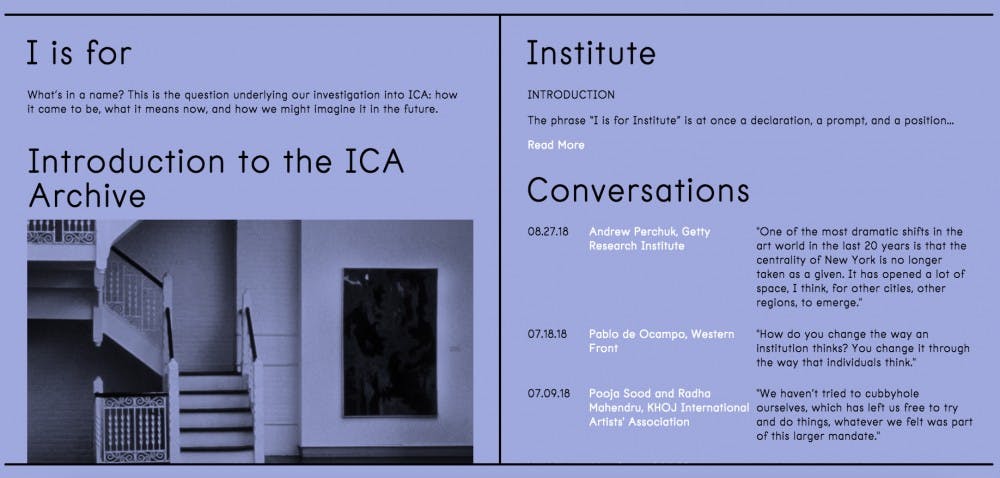"What's in a name?" a gangly sans font asks against the webpage's lavender backdrop.
The four words, though simple in pronunciation and text, encapsulates the driving force of Institute of Contemporary Art's interrogation of the role of art institutes as a whole. Consisting of interviews, articles, and manuscripts, the results of ICA's exploration form the interactive website, I is for Institute.
Beyond being an informative display of the ICA's past, I is for Institute aims first and foremost to address the individual's role within an arts organization, as the website's introduction notes, "the 'I' in I is for Institute acknowledges that institutions are composed of people and rooted in places." Among the countless unaffiliated ICAs around the world, what best defines each organization are the individuals involved—the directors, curators, and audiences who shape the institutions they come in contact with. The introduction states, "I is for Institute is necessarily a collaborative project, one that can only be realized with the participation of our peers...Over long-distance phone calls, Skype chats, frequent emails, and in-person meetings, directors and curators offered invaluable perspectives on what it means to work in, build, and re-envision contemporary arts organizations today." Dialogues with the curators of arts institutes from around the globe, acquired via meticulous compiling and the generous volunteering of interviewees, form the centerpiece of I is for Institute. Not only do they offer unique perspectives on each person's understanding of art institutes, the transcribed conversations and recorded videos also address the importance of the individual in defining an institute.

Photo Courtesy of the ICA Philadelphia
According to both organizers of I is for Institute—Alex Klein, a Dorothy and Stephen R. Weber (CHE'60) Curator, and Tausif Noor, a Spiegel-Wilkes Curatorial Fellow—the seeds of the project were planted in 2013, during ICA's 50th anniversary celebration. In an email, they note, "we spent a lot of time going through our archives and thinking deeply about the many extraordinary artists, curators, and exhibitions that had shaped our history." A sprouting of questions soon followed—"Why were we initially formed as an institute?....What does the notion of an 'institute' conjure for a public?.."—all of which eventually flowered into the project we see today. Both organizers "felt it was necessary to reach out to colleagues working in contemporary arts organizations internationally to learn about their perspectives on the work that they do in their respective contexts."
In addition to a focus on present interactions, I is for Institute digs into the past. In "Introduction to the ICA Archive," written by Maeve Coudrelle, a PhD candidate in Art History at Temple University, she notes, "It was fascinating to get a behind-the-scenes look into the kinds of conversations that arise when an arts organization is founded." Coudrelle continues, "...notes from an Advisory Board Meeting in 1967, for example, shed light on the initial (and enduring) dual purposes of the ICA—in Dean G. Holmes Perkins’ words, to '1. Bring art to the city [and] 2. Bring art to the campus.'” Over the course of the next thirty years, the ICA's mission visibly evolved to encompass something greater. In Coudrelle's words, "...statements emphasized the ICA’s growing international audience—through our organization of the U.S. contributions to the São Paulo Bienal in 1975 and the Venice Biennale in 1980."

In a 1963 letter from Joel S. Berger to Chester E. Tucker, Berger describes how a colleague had "...some question whether it would be an 'institute' or would be designated by another title." Statements such as these, Coudrelle elaborates, shed light on "...questions that we have been exploring; namely, what it means to be an 'institute', as opposed to, say, a 'museum' or a 'center.'" An institute would imply scientific research, it brings to mind the analytical work of a laboratory. A museum would entail the housing of a permanent collection. According to Coudrelle, "This emphasizes ICA’s identity as a laboratory for knowledge creation."
I is for Institute is an ongoing project, simultaneously digging into its past while exploring the present. According to Klein and Noor in an email, "the challenge of this project is that it could in theory continue ad infinitum. There are so many wonderful individuals working in contemporary arts organizations all over the world, and there isn’t enough time or the resources to speak with all of them." With so many perspectives to engage with, the difficulty of the project is "...keeping up with the workload."
Ultimately, both organizers hope that by reading the website, audiences will come to understand the breadth of contemporary arts organizations as well as the depth of their research and work. The fruits of their labor, Klein and Noor conclude, are difficult to quantify, but certainly impactful. "We will be happy if one of the outcomes of the project is more transparency about how contemporary arts organization work and the thinking of the individuals who work in them." Between the transcribed interviews, the anonymous queries, the personal essays, and the recorded videos, I is for Institute is, as Klein and Noor write, "...purposely informal in nature, and we hope that the reader feels welcome at the table."

